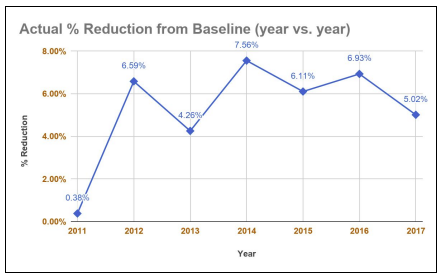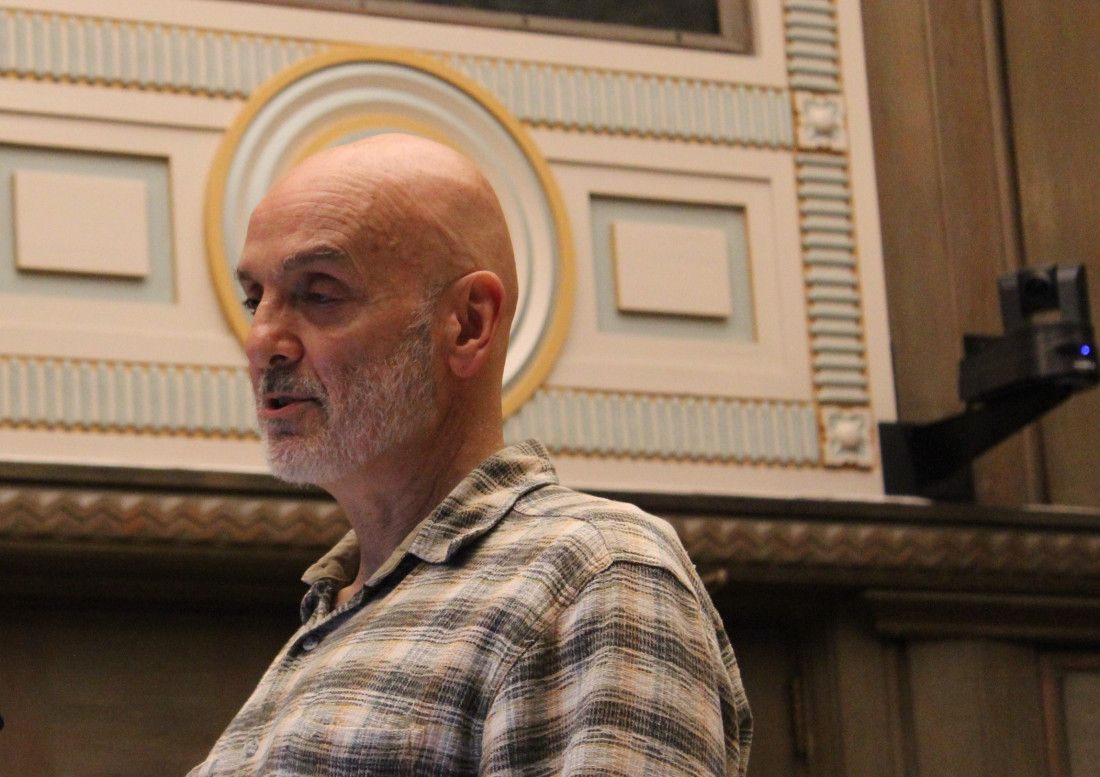Progress toward Asheville’s waste and carbon reduction goals has moved in the wrong direction in the past year, Sustainability Officer Amber Weaver told members of Asheville City Council at their regular meeting on April 10.
“From 2016 to 2017, we actually slipped and lost traction with our waste goal,” Weaver said, explaining that the city’s current goal is a 50 percent reduction in solid waste sent to the landfill by 2035. In 2016, the city achieved a nearly 7 percent reduction, but in 2017, the reduction was only 5 percent.
Population growth is one culprit, since the measurement is based on the aggregate volume of waste collected in the city, Weaver explained. A second possible explanation for the backtracking relates to waste generated by commercial customers. Since the city doesn’t collect recycling from businesses, “There’s not an offset there,” Weaver said. Growth in commercial waste volume is not balanced by a corresponding increase in recycling volume, since the businesses must contract separately with Curbside Management for that service.
Efforts to reduce the city’s carbon footprint by 80 percent from a 2008 baseline by 2039, Bridget Herring told Council, also yielded less-than-hoped-for results. For the first time since the goal’s adoption, in 2017 the city didn’t achieve its annual reduction target. Herring, the city’s energy program coordinator, attributed the slowdown to growth, as well as the increased use of electricity for amenities like outdoor lighting in city parks and greenways and the city’s transition to electric buses. City-employee commuting patterns also contribute to the trend: Only a quarter of those employed by the city live inside city limits, Herring said. Over the past two years, city staff has grown by 6.5 percent, and the average distance employees travel to get to work has increased 3.9 percent.
Waste not
Asked by Asheville Mayor Esther Manheimer what sorts of programs could help move the needle on the solid waste goal, Weaver pointed to a proposal in the fiscal year 2018-19 budget (which Council has not yet adopted) to develop a solid waste management plan; she also advocated for adding a staff position to focus on solid waste reduction. “The goal is to use all the data that we’ve gathered over the past years, for pay-as-you-throw and our organics feasibility study, and to be able to incorporate that into a long-range plan,” she said.

Council member Julie Mayfield elaborated on the pay-as-you-throw planning effort, explaining that its purpose was to create financial incentives for residents to recycle a larger percentage of their waste, thereby reducing the volume of garbage the city collects.
“In order for a pay-as-you-throw program to be successful, you have to be paying the true amount of what it costs to pick up waste per household,” Weaver responded. The city’s sanitation and public works departments estimate that at $22 per month. “So we’re not there yet,” Weaver said. “You would want to be capturing that fee, so that you could offer a lesser amount if you’re throwing away a lesser amount.”
The thought of raising trash collection fees as a prelude to implementing a variable pricing scheme for garbage collection seemed to give Manheimer pause. “We still subsidize trash pickup significantly,” she said. “I have, like, PTSD from when we took away leaf vacuuming; this is a far more radical change. A far more radical change.”
Carbon dating
In 2017, the city missed its 4 percent annual carbon reduction goal, adding 249 tons more carbon dioxide to the atmosphere than the city had targeted, Herring said. The challenge is continuing to reduce city emissions from the 2008 baseline while also offsetting growth and increased use of electricity.
“Our goal is no trash and no carbon, and it’s hard to get there,” Manheimer quipped.

“What do you need from us to make sure you get back on track?” Mayfield asked. Unfortunately, Herring said, no initiative on the horizon has the potential to positively impact the city’s carbon reduction goals to the extent that the 2012-13 $2.5 million streetlight replacement project did. Smaller projects are “more economical, but you’re not going to see the bigger gains,” she said. Still, the city is moving ahead on a number of fronts. “It’s going to continue to be a challenge to find something that’s going to get us those big chunks, unless we invest in something citywide. Or put a lot more investment into it,” Herring said.
Ongoing initiatives include the community clean energy policy framework that aims to create a clean energy economy, the Energy Innovation Task Force and a climate resiliency assessment in collaboration with the National Environmental Modeling and Analysis Center at UNC Asheville.
Weaver also outlined her department’s work in support of the city’s Food Policy Action Plan, the Asheville Edibles Community Garden program and the Adopt-a-Spot program. The full report is available here.
Affordable housing
The meeting’s one public hearing concerned a zoning request for an affordable apartment complex off Smokey Park Highway in Candler. Developer Workforce Homestead’s proposal would create 70 units of housing affordable to residents earning 60 percent of the area median income or less; the units would remain affordable for 30 years.
The 5.89-acre wooded project site abuts the Westridge Shopping Center. Plans show three apartment buildings plus a clubhouse. Jimmy Yamin of Workforce Homestead said the development will offer a convenient location for working families and added that such parcels are difficult to find in the Asheville area.
No member of the public commented on the proposal, and Council approved the zoning request unanimously.
Later in the meeting, Council also considered requests from Workforce Homestead and Mountain Housing Opportunities for loans from the city’s Affordable Housing Trust Fund. Workforce Homestead requested $600,000 for the Amaranth Apartments, while Mountain Housing Opportunities asked for a $1.8 million loan to support an 80-unit apartment development at 357 Hilliard Ave., across the street from the site of the city’s former parks maintenance facility.
At the MHO development, 60 of the units will be affordable to residents earning 60 percent of area median income or less, while 20 units will be available at market rates. Both the total amount of the Mountain Housing Opportunities loan request ($1.8 million) and the per-unit commitment ($30,000 per unit) exceed city policy maximums (which are $1 million and $20,000, respectively). Council member Vijay Kapoor asked to consider the two projects separately; he voted against the MHO project but in favor of the Amaranth Apartments. Other Council members voted in favor of both funding requests.
City staff noted that both projects are also applying for funding from the N.C. Housing Finance Agency. Those funding decisions will be announced in August. In both cases, a negative decision from the agency would result in the project failing to move forward.
City fees and charges
Council approved fees and charges for the fiscal year 2018-19, including a 2 percent increase in residential water rates, a 5 percent increase in stormwater fees for homeowners and increases in a variety of fees for planning and permitting through the city’s Development Services Department. No member of the public commented on the proposed fee changes, which passed on a vote of 5-2 with Council members Brian Haynes and Keith Young opposed.
Human Relations Commission
Council voted unanimously to create a city Human Relations Commission, which will:
- Make policy recommendations to Council on steps to advance equity.
- Support the city Office of Equity and Inclusion.
- Provide a forum for discussion of resident concerns and complaints regarding human relations.
- Engage the community in city programs and policies regarding human relations.
- Promote and improve human relations and advance equity in the areas of public safety; educational, art and cultural opportunities; economic development; health and human services; and housing.
The commission will be made up of 15 members appointed by City Council.
Other business
Council heard a presentation from Roderick Simmons, city Parks and Recreation director, on his department’s efforts to allocate resources and develop programming in an equitable manner that eliminates “distributional differences” among city neighborhoods and facilities. Simmons described a variety of initiatives, including a scoring system for funding decisions that takes neighborhood characteristics into consideration; shifting to individual neighborhood service plans rather than citywide plans; and revamping the way the department engages with the community, including using a facilitator for community meetings and allowing the community to direct planning efforts to a greater extent than in the past.
Simmons said future projects include working to add bus service to the city’s Recreation Park to increase access to that facility for underserved youths and creating a workforce development program for middle and high school students that would provide a pathway to employment with the Parks and Recreation Department.
Council members praised the department’s efforts to achieve an equitable distribution of parks and recreation resources and urged Simmons to keep up the good work.
David Uchiyama, spokesperson for N.C. Department of Transportation’s Division 13 office in Asheville, briefed City Council on plans to ensure continuous passage for boaters on the French Broad River during the NCDOT’s planned widening of Interstate 26 from Airport Road to Interstate 40. The project area includes two bridges that cross the French Broad River. Throughout construction, Uchiyama said, a safe passage lane will be marked for boaters, and “catchment” structures mounted underneath bridges will provide protection for those passing below.
Council appointed Scott Powell and Gail Miller to the newly created Audit Committee. Tim Schaller was appointed to the Riverfront Area Redevelopment Commission. Council decided to readvertise for applicants to a vacancy on the Multimodal Transportation Commission.
Council adopted its consent agenda unanimously. Council went into closed session to discuss matters covered by attorney-client privilege, the acquisition of real property and the expansion of industry at 7:20 p.m.
Council’s next meeting will take place on Tuesday, April 24 at 5 p.m. Prior to the meeting, the full Council will meet at 3 p.m. in the first floor north conference room in City Hall for the third budget work session for the fiscal year 2018-19 budget, which is scheduled to be adopted on Tuesday, June 19. The new fiscal year begins July 1.



Isn’t it ironic that such a liberal progressive utopic city like Asheville would even need a city government office of ‘Equity and Inclusion’ . Where is the equity and inclusion in maintaining two separate government school systems ? ? ? True DIVERSITY is only achieved with system wide consolidation, yet the taxpayers get nailed to fund TWO systems. STOP the MADNESS. STOP the elitist exclusionists who DICTATE dual systems …now.
LOL why what would they do with all those gift cards? Graft and corruption is the norm for progressive after all. When taxpayers are nothing more that walking wallets to be stolen from, these loons don’t care.